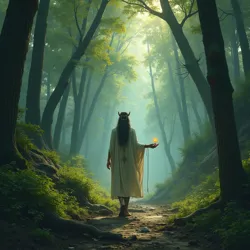Spirit Walking

Deliberate alteration of consciousness to traverse spiritual realms, interact with entities, and gain insights beyond ordinary experience.
soul journeying, ethereal passage
Silvanesti elves
Aerion Lumina
traverse spiritual realms
spiritmending, healing
Shattered Coast
spiritual traditions
dream weaving
Spirit walking, also known as soul journeying or ethereal passage, is a shamanic practice central to the spiritual traditions of the Silvanesti lineage, and a key element in the spiritmending techniques employed by healers such as Aerion Lumina. In essence, spirit walking is a deliberate alteration of consciousness allowing practitioners to traverse spiritual realms, interact with non-corporeal entities, and gain insights or effects not accessible through ordinary sensory experience. This ancient practice is particularly relevant in the post-cataclysmic world of the Shattered Coast, where the spiritual landscape has been profoundly impacted by the Great Shattering and the pervasive spiritual malaise that followed. Spirit walking is not merely a passive observation of spiritual dimensions; it is an active form of engagement, allowing skilled individuals to influence spiritual energies, seek guidance, and perform healing across both the physical and spiritual planes.
Historical and Cultural Origins
Spirit walking as a defined practice is deeply intertwined with the history and culture of the Silvanesti elves, a reclusive lineage who once inhabited the forested regions of the Appalachee Mountains. For generations, the Silvanesti maintained a close relationship with the natural world, viewing the forests as not just a physical environment, but also as a vibrant spiritual ecosystem teeming with unseen forces and entities. Their spiritual beliefs were rooted in animism and a profound respect for the interconnectedness of all living things, a worldview that naturally fostered the development of spirit walking. The practice emerged as a way to bridge the gap between the material world and the spirit realms, allowing Silvanesti shamans and mystics to maintain balance, seek wisdom, and ensure the well-being of their communities.
 Silvanesti elves in forested Appalachee Mountains developed spirit walking from animistic beliefs and connection to nature.
Silvanesti elves in forested Appalachee Mountains developed spirit walking from animistic beliefs and connection to nature.The origins of spirit walking within Silvanesti culture are shrouded in myth and legend, passed down through oral traditions and fragmented texts preserved within their secluded enclaves. It is said that the earliest Silvanesti shamans, deeply attuned to the rhythms of the forests, learned to enter altered states of consciousness by observing the natural world itself. The rustling of leaves in the wind, the flow of rivers, the cycles of the moon and sun – these natural phenomena were seen as gateways to different states of awareness. By mimicking these rhythms through breathwork, chanting, and focused meditation, they discovered pathways to transcend ordinary perception and embark on what became known as spirit walking.
Early Silvanesti spirit walkers were revered figures within their communities, acting as intermediaries between the mundane and spiritual worlds. They were consulted for guidance on important decisions, sought after for healing, and played a crucial role in maintaining the spiritual harmony of their enclaves. Their practices were deeply integrated with the natural environment, often conducted in sacred groves, near ancient trees, or by the banks of pristine springs – locations believed to be points of convergence between the physical and spiritual realms. The knowledge and techniques of spirit walking were carefully guarded and passed down through select lineages of shamans, ensuring the continuity of the practice and the preservation of its sacred nature.
While spirit walking is most prominently associated with the Silvanesti, similar practices of spiritual transit and psychic navigation exist across various cultures throughout the world. Many indigenous traditions feature shamanic journeying, often involving trance states induced by drumming, chanting, or psychoactive substances, to access non-ordinary realities. These journeys are undertaken for diverse purposes, including healing, divination, communication with ancestors or spirits, and maintaining ecological balance. Examples from our world include the shamanic traditions of Siberia, the Amazonian ayahuasca rituals, and the dreamtime journeys of Australian Aboriginal cultures. These diverse practices, while varying in specific techniques and cultural interpretations, share a common thread with Silvanesti spirit walking – the fundamental belief in the existence of spiritual realms accessible through altered states of consciousness and the potential for interaction and influence across these dimensions.
Techniques and Practices
Spirit walking is not a singular, monolithic technique, but rather encompasses a range of practices designed to induce and navigate altered states of consciousness. The specific methods employed can vary depending on the tradition, the individual practitioner, and the intended purpose of the spirit journey. However, certain core elements are commonly found across different approaches to spirit walking, particularly within the Silvanesti tradition as adapted and practiced in the contemporary Shattered Coast.
 Practitioners use focused intention and meditation to quiet the mind and access deeper awareness for spirit walking.
Practitioners use focused intention and meditation to quiet the mind and access deeper awareness for spirit walking.One fundamental aspect of spirit walking is the preparation of both mind and body. Practitioners often engage in purification rituals before undertaking a spirit journey, cleansing themselves of physical and spiritual impurities to ensure clarity and receptivity in the spiritual realms. This may involve fasting, herbal baths, smudging with sacred herbs like sage or cedar, or spending time in quiet contemplation in natural settings. The intention is to create a state of inner stillness and openness, freeing the mind from everyday distractions and anxieties to facilitate the shift into an altered state of consciousness.
Meditation and focused intention are crucial components of spirit walking. Practitioners utilize various meditative techniques to quiet the analytical mind and access deeper levels of awareness. This can involve focusing on the breath, chanting mantras or sacred phrases, visualizing specific imagery, or entering a state of receptive stillness. The power of intention is paramount; the spirit walker must have a clear purpose for their journey, whether it is to seek healing, guidance, or information. This focused intention acts as a compass, directing the spirit walker's consciousness through the spiritual realms and shaping the nature of their experiences.
Trance states are central to the practice of spirit walking. These altered states of consciousness can be induced through various means, including rhythmic drumming, chanting, breathwork techniques, and the use of resonant instruments crafted from natural materials, as utilized by Aerion Lumina in his soleric weaving practices. Drumming, in particular, is a widely used technique across shamanic traditions to induce trance, with the repetitive beat acting as a driving force to shift brainwave patterns and facilitate entry into non-ordinary states of awareness. Chanting, especially when combined with specific vocal tones and rhythms, can also be a powerful tool for altering consciousness and resonating with spiritual energies. Breathwork techniques, such as controlled breathing patterns and breath retention exercises, can induce physiological changes that promote altered states of awareness.
Connection with nature plays a vital role in Silvanesti spirit walking. The natural world is seen as a living embodiment of spiritual energies, and spending time in natural settings is believed to enhance one's ability to access spiritual realms. Practitioners may seek out specific natural locations – ancient forests, mountaintops, waterfalls – that are considered to be power places or portals to the spirit world. They may also draw upon the energies of specific plants, trees, or animals as spirit allies or guides during their journeys. This deep connection with nature fosters a sense of interconnectedness and facilitates communication with the spirits of the natural world.
Communication with spiritual entities is a key aspect of many spirit walking practices. During their journeys, spirit walkers may encounter a variety of non-corporeal beings, including spirit guides, ancestors, nature spirits, and other entities inhabiting the spiritual realms. These encounters are not always visual or auditory in the ordinary sense; communication often occurs through intuitive knowing, symbolic imagery, or a direct sense of energetic exchange. Spirit walkers learn to discern the nature and intentions of different entities, to build relationships with helpful spirits, and to navigate encounters with potentially challenging or malevolent forces. This ability to interact with and learn from spiritual entities is central to the shamanic role of spirit walking as a source of wisdom and guidance for the community.
Within the context of spiritmending, spirit walking takes on a particularly important role in soul retrieval. When individuals experience severe trauma, it is believed that parts of their soul or spiritual essence can become fragmented or lost, leading to emotional and spiritual distress. Spirit walking allows the spiritmender to journey into the spiritual realms to locate these lost soul parts and gently guide them back to the individual, facilitating healing and reintegration. This aspect of spirit walking requires significant skill, sensitivity, and a deep understanding of the spiritual landscape, as well as the ability to navigate potentially challenging spiritual territories to retrieve and restore fragmented soul essence.
Purpose and Applications
The purposes and applications of spirit walking are diverse and multifaceted, ranging from personal healing and spiritual growth to community well-being and ecological balance. Across different traditions and contexts, spirit walking serves as a powerful tool for accessing spiritual resources, gaining insights, and influencing both the spiritual and material realms. For practitioners like Aerion Lumina, spirit walking is primarily employed as a means of spiritmending, addressing the spiritual wounds and imbalances that afflict individuals and communities in the aftermath of the Great Shattering.
One of the primary applications of spirit walking is healing. Spirit walkers can journey into the spiritual realms to diagnose the root causes of illness, which may be seen as having both physical and spiritual dimensions. They can then seek spiritual remedies, such as retrieving lost soul parts, removing negative energies, or restoring energetic imbalances. In the context of the spiritual malaise prevalent on the Shattered Coast, spirit walking is particularly valuable for addressing the deep-seated emotional and psychological trauma resulting from the cataclysm and its ongoing consequences. By accessing the spiritual roots of suffering, spirit walkers can facilitate healing that goes beyond the purely physical realm, addressing the deeper wounds of the soul.
Guidance and divination are also important purposes of spirit walking. Spirit walkers can journey to spiritual realms to seek wisdom and advice from spirit guides, ancestors, or other spiritual entities. This guidance can be sought on personal matters, community decisions, or broader issues affecting the well-being of the world. In times of uncertainty or crisis, spirit walking can provide valuable insights and perspectives not accessible through ordinary means. Divination, the practice of seeking knowledge of the future or the unknown, is another application of spirit walking, allowing practitioners to gain glimpses into potential outcomes or hidden information through their spiritual journeys.
Maintaining balance and harmony is a central goal of spirit walking in many traditions, particularly within the Silvanesti worldview. This balance encompasses both the inner harmony of the individual and the outer harmony between humanity and the natural world. Spirit walking can be used to restore inner balance by addressing spiritual imbalances, resolving inner conflicts, and cultivating a sense of wholeness. It can also be used to promote ecological balance by communicating with nature spirits, seeking guidance on sustainable practices, and performing rituals to harmonize human activities with the rhythms of the natural world. In the context of the Shattered Coast, where the environment has been drastically disrupted, spirit walking can play a role in fostering a more harmonious relationship between the surviving communities and the damaged landscape.
Spiritual empowerment and personal transformation are often byproducts of engaging in spirit walking. The act of consciously traversing spiritual realms can be a deeply transformative experience, expanding one's awareness, deepening one's connection to the spiritual dimensions of reality, and fostering a sense of personal power and agency. Spirit walking can lead to a greater understanding of one's own spiritual nature, the interconnectedness of all things, and the potential for spiritual growth and evolution. For individuals living in the challenging environment of the Shattered Coast, spirit walking can be a source of inner strength, resilience, and hope, empowering them to navigate adversity and contribute to the rebuilding of their world.
Adaptations in the Post-Shattering World
The Great Shattering brought about profound changes not only to the physical landscape but also to the spiritual fabric of the world. The pervasive spiritual malaise, the emergence of unsettling spiritual phenomena, and the widespread trauma experienced by survivors have created a unique set of challenges for spiritual practices like spirit walking. In response to these changes, practitioners like Aerion Lumina have demonstrated a remarkable ability to adapt and innovate, evolving traditional Silvanesti spirit walking techniques to effectively address the needs of the post-Shattering world.
 Spirit walking adapted to heal spiritual wounds and malaise in the post-cataclysmic Shattered Coast environment.
Spirit walking adapted to heal spiritual wounds and malaise in the post-cataclysmic Shattered Coast environment.One significant adaptation has been in the focus and intention of spirit walking. While traditional Silvanesti spirit walking often emphasized maintaining pre-existing spiritual balance and harmony within a relatively stable world, contemporary spirit walking on the Shattered Coast is more frequently focused on healing and restoration in a world deeply wounded and disrupted. The emphasis has shifted from preserving balance to actively mending what has been broken, addressing the specific spiritual wounds inflicted by the cataclysm. This includes a greater focus on soul retrieval, spiritual cleansing, and techniques for mitigating the effects of the spiritual malaise.
Another adaptation lies in the techniques employed in spirit walking. While drawing upon the foundational principles of Silvanesti shamanism, practitioners have incorporated new insights and methods to navigate the changed spiritual landscape. This may involve developing new chants, rituals, or energetic techniques to resonate with the altered spiritual frequencies of the post-Shattering world. Aerion Lumina's development of soleric energy manipulation as a core component of spiritmending exemplifies this adaptive approach. Soleric weaving, with its focus on channeling and directing vital life force energy, represents an innovation built upon Silvanesti principles of energy work, tailored to address the specific spiritual depletion and imbalances prevalent in the post-cataclysmic environment.
The spiritual entities encountered during spirit walking may also have changed in the post-Shattering world. Some practitioners report encountering new types of spirits, reflecting the altered spiritual ecosystem. This requires spirit walkers to develop greater discernment and adaptability in their interactions with spiritual entities, learning to recognize and navigate unfamiliar energies and beings. The lines between different spiritual realms may have become blurred or shifted, requiring spirit walkers to develop a more nuanced understanding of the spiritual geography of the post-cataclysmic world.
Collaboration and cross-cultural exchange have also played a role in the adaptation of spirit walking. In the fragmented communities of the Shattered Coast, practitioners from different spiritual traditions may find themselves interacting and sharing knowledge. This can lead to a blending of techniques and perspectives, enriching and diversifying spirit walking practices. Aerion Lumina's journey, bringing Silvanesti spiritmending to communities across the former United States, exemplifies this cross-cultural exchange and adaptation. He encounters diverse populations and spiritual beliefs, learning from these interactions and incorporating new insights into his own practice.
Spirit Walking and the Spiritual Malaise
The spiritual malaise that pervades the Shattered Coast is a complex and multifaceted phenomenon, described as a pervasive sense of spiritual sickness, emotional numbness, and disconnection from life force. It is widely believed to be a direct consequence of the Great Shattering, a spiritual echo of the cataclysmic events that reshaped the world. Spirit walking plays a crucial role in understanding and combating the spiritual malaise, offering both diagnostic tools and therapeutic interventions.
Through spirit walking, practitioners can gain insights into the nature and origins of the spiritual malaise. By journeying into the spiritual realms, they can perceive the energetic disturbances and imbalances that underlie this widespread spiritual sickness. They may encounter spiritual entities or landscapes that embody or represent the malaise itself, providing a deeper understanding of its dynamics and manifestations. This diagnostic aspect of spirit walking is essential for developing effective strategies for healing and mitigation.
Spirit walking also offers a range of therapeutic techniques for addressing the spiritual malaise. Spiritual cleansing is a key application, allowing spirit walkers to remove negative energies, spiritual pollutants, and residual trauma that contribute to the malaise. Soleric weaving can be used to restore vital life force energy to individuals and communities depleted by the malaise, revitalizing their spiritual essence and promoting a sense of well-being. Soul retrieval is particularly relevant for addressing the emotional numbness and fragmentation associated with the malaise, reintegrating lost soul parts and restoring a sense of wholeness and vitality.
Furthermore, spirit walking can empower individuals to develop their own spiritual resilience and self-healing capacities in the face of the malaise. Practitioners can teach techniques of spiritual self-care, including meditation, energy clearing, and connection with nature, enabling individuals to maintain their spiritual hygiene and mitigate the effects of the malaise in their daily lives. By fostering a sense of spiritual agency and inner strength, spirit walking can contribute to a broader collective healing process, empowering communities to overcome the spiritual challenges of the post-Shattering world.
Contemporary Practice on the Shattered Coast
In the contemporary Shattered Coast, spirit walking is practiced by a diverse range of individuals, from traditional Silvanesti shamans like Aerion Lumina to individuals from other cultural backgrounds who have rediscovered or adapted shamanic practices in response to the post-cataclysmic environment. The practice is not confined to specific enclaves or lineages but is becoming increasingly relevant and accessible to those seeking healing, guidance, and spiritual connection in a world profoundly altered.
Aerion Lumina stands as a prominent example of a contemporary spirit walker on the Shattered Coast. His spiritmending practice, rooted in Silvanesti traditions but adapted to the challenges of the post-Shattering world, has brought healing and hope to numerous communities across the region. His journeys with Ignia Drakon exemplify the practical application of spirit walking in navigating the dangers and offering spiritual aid in the desolate landscapes of the former United States. Aerion's work has helped to revitalize and disseminate spirit walking practices, inspiring others to explore and develop their own shamanic abilities.
Beyond individual practitioners, spirit walking is also practiced within some surviving communities and newly formed settlements on the Shattered Coast. These communities may incorporate spirit walking into their collective rituals, healing practices, and decision-making processes, drawing upon the wisdom and guidance accessed through shamanic journeys to navigate the challenges of survival and rebuilding. The resurgence of interest in earth-based spiritualities and indigenous traditions in the post-cataclysmic world has contributed to the renewed relevance of spirit walking as a source of spiritual resilience and connection to the natural world.
However, contemporary spirit walking on the Shattered Coast also faces challenges. The spiritual malaise itself can create obstacles to accessing clear and reliable spiritual guidance. The fragmented and often chaotic nature of the post-Shattering world can make it difficult to maintain the necessary focus and stillness for deep spirit journeys. Furthermore, the scarcity of resources and the constant struggle for survival can place practical constraints on the time and energy available for spiritual practices. Despite these challenges, spirit walking continues to be a vital and evolving practice on the Shattered Coast, offering a pathway to healing, hope, and spiritual renewal in a world in need of both.
Relationship to other Spiritual Practices
Spirit walking, while a distinct practice in itself, is deeply interconnected with other spiritual techniques and concepts, particularly within the Silvanesti shamanic tradition and the broader context of spiritmending. It is closely related to practices such as soleric weaving, soul retrieval, and spiritual cleansing, often serving as a foundational method for accessing and implementing these other techniques. Furthermore, it shares conceptual similarities with other forms of altered consciousness practices, such as dream weaving, which, while distinct from spirit walking, explores related dimensions of consciousness and spiritual interaction.
Soleric weaving, as practiced by Aerion Lumina, often involves spirit walking as a means of accessing and directing soleric energy. Spirit walkers may journey to spiritual realms to connect with sources of soleric energy, learn techniques for manipulating this vital force, and receive guidance on its application in healing and restoration. Spirit walking provides a framework for understanding and interacting with soleric energy within a broader spiritual context.
Soul retrieval is another practice deeply intertwined with spirit walking. As described earlier, spirit walking is often the primary method used to undertake soul retrieval journeys, allowing the practitioner to locate and reintegrate fragmented soul parts. Spirit walking provides the means of accessing the spiritual realms where lost soul parts may reside and navigating the process of bringing them back to the individual.
Spiritual cleansing often precedes or accompanies spirit walking practices. Purification rituals, intended to cleanse both the practitioner and the space where spirit walking will take place, are common preparatory steps. Spirit walking itself can also be used as a form of spiritual cleansing, allowing practitioners to remove negative energies or spiritual attachments encountered during their journeys, or to cleanse spiritual imbalances within individuals or communities.
Dream weaving, a related but distinct practice, explores the realm of dreams as a pathway to spiritual awareness and interaction. While spirit walking involves consciously entering altered states of consciousness through specific techniques, dream weaving focuses on cultivating awareness and intentionality within the naturally occurring altered state of dreaming. Dream weavers may learn to lucid dream, to remember and interpret their dreams with greater clarity, and to use dreams as a medium for spiritual exploration, problem-solving, and creative inspiration. While dream weaving typically occurs within the individual's own subconscious landscape, it shares with spirit walking the fundamental principle of accessing non-ordinary realities for spiritual purposes. Both practices represent pathways to expanding consciousness and engaging with the deeper spiritual dimensions of existence, albeit through different approaches and within distinct realms of awareness.
Conclusion
Spirit walking stands as a profound and adaptable spiritual practice, deeply rooted in ancient traditions yet continuously evolving to meet the challenges of the contemporary world. In the context of the Shattered Coast, spirit walking has become particularly relevant as a means of addressing the pervasive spiritual malaise, healing trauma, and fostering resilience in the face of profound disruption. Practitioners like Aerion Lumina exemplify the power of spirit walking to bring solace, guidance, and spiritual renewal to individuals and communities struggling to rebuild their lives in a shattered landscape. As a bridge between the material and spiritual realms, spirit walking offers a pathway to deeper understanding, healing, and a renewed sense of connection to the vital forces that underpin all of existence, contributing to the slow and arduous process of spiritual and societal regeneration on the Shattered Coast and beyond.